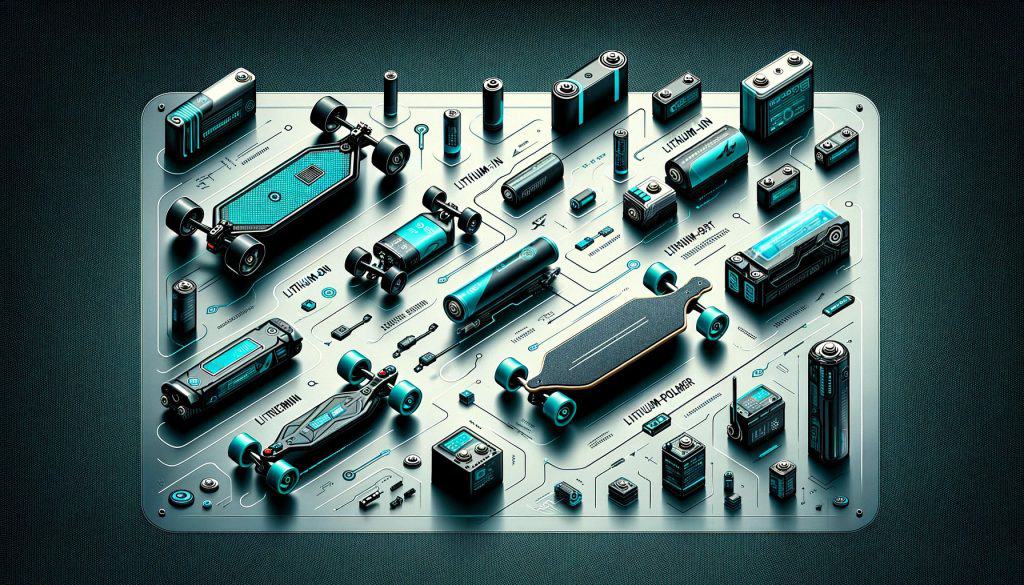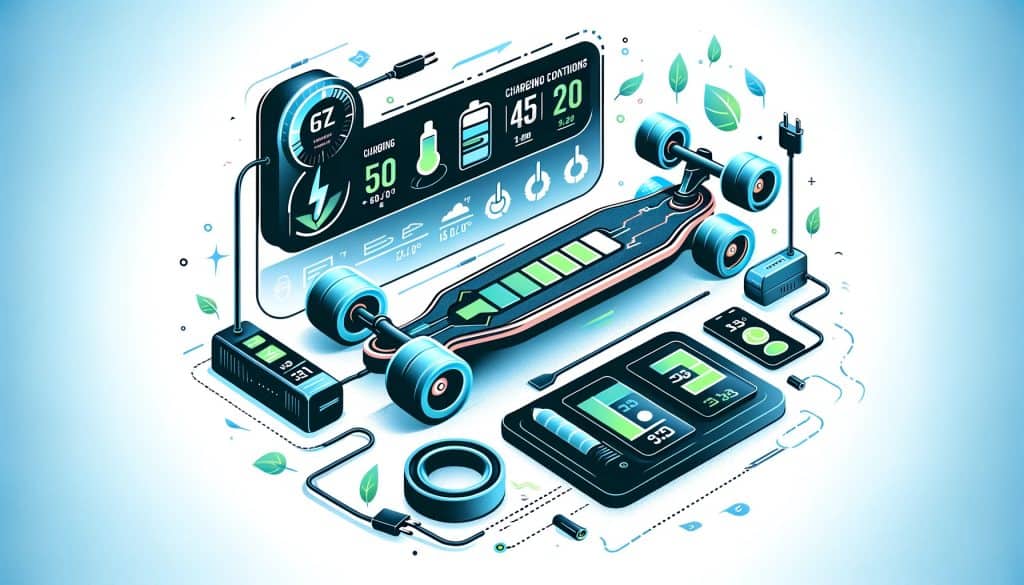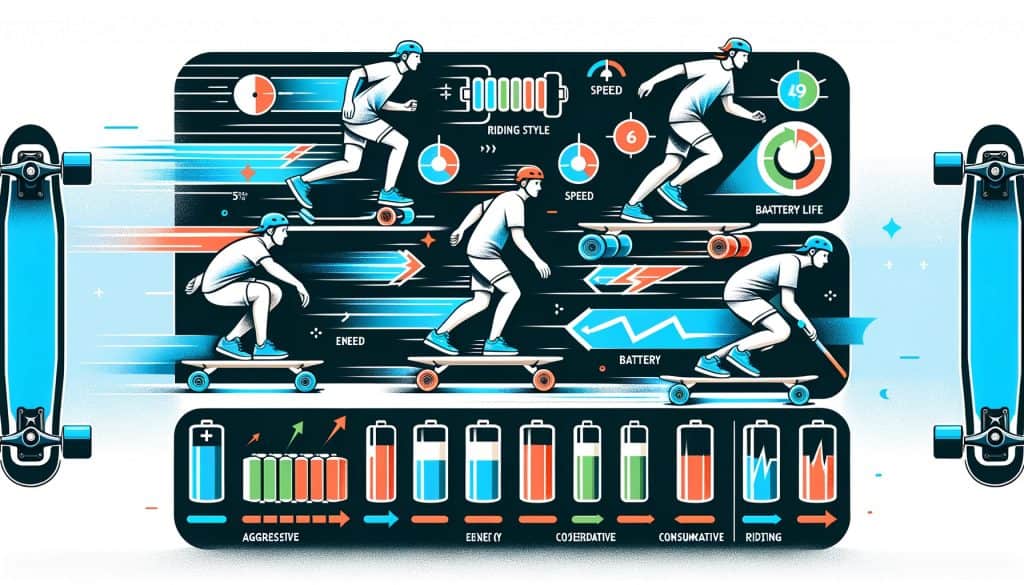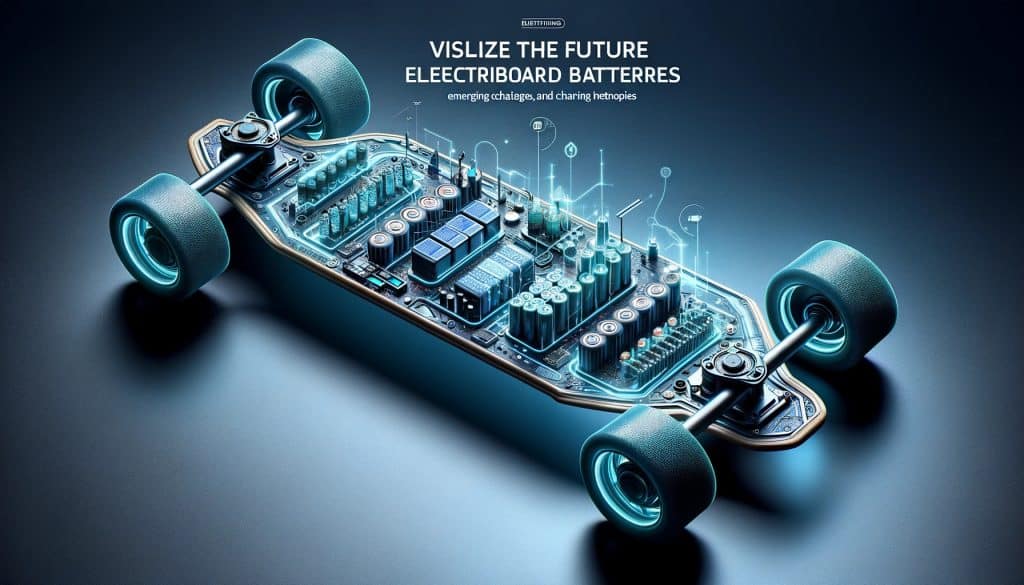The Critical Role of Battery Life in Electric Longboards
Imagine cruising t ough the city streets on your electric longboard, the breeze against your face, swiftly maneuvering around obstacles with ease. This exhilarating experience, however, hinges on one crucial factor: battery life.
The importance of a long-lasting battery in an electric longboard cannot be overstated. It’s the heart of your ride, determining not just how far you can go, but also how you experience the journey.
Why Battery Life Matters
- Range and Freedom: The primary appeal of an electric longboard is the freedom it offers. You can cover significant distances without the physical exertion required by traditional skateboards. But this freedom is directly tied to your battery’s capacity. A longer-lasting battery means more time on the road and less time tethered to a charging point.
- Consistent Performance: As battery life dwindles, so can the performance of your longboard. Speed, torque, and braking efficiency may all suffer as the battery drains, potentially impacting your riding experience and safety.
- Convenience and Reliability: For many, electric longboards are more than just a hobby; they’re a key mode of transportation. Maximizing battery life ensures that your board is ready when you need it, making your daily commute or leisurely rides more reliable and convenient.
- Long-Term Cost Efficiency: Batteries are one of the most expensive components of an electric longboard. Maximizing their life not only saves you the inconvenience of frequent replacements but also reduces long-term costs.
- Environmental Impact: Electric longboards are a green alternative to gas-powered vehicles. Maximizing battery life contributes to this eco-friendly aspect by reducing waste and the frequent need for battery production and disposal.
Comparing Battery Life and its Impact
| Factor | Short Battery Life | Long Battery Life |
|---|---|---|
| Range | Limited distance | Extensive distance |
| Performance | Decreases over time | Remains consistent |
| Reliability | Frequent recharging needed | Ready for longer trips |
| Cost Efficiency | Frequent replacements needed | Less frequent replacements |
| Environmental Impact | Higher due to frequent replacements | Lower, more sustainable |
So as you can see, the battery is more than just a part of your electric longboard; it’s the lifeline that powers your adventures. By understanding and prioritizing battery life, enthusiasts can ensure a superior and uninterrupted riding experience.
This isn’t just about technology; it’s about embracing a lifestyle that combines excitement, efficiency, and responsibility.
< class="wp-block-separator has-alpha-channel-opacity"/>Understanding Your Electric Longboard’s Battery
The battery of an electric longboard is not just a power source; it’s a sophisticated component that significantly influences the board’s performance. Understanding the types of batteries used and the basic principles of battery technology is key to maximizing your longboard’s potential. Let’s dive into this electrifying world.

Types of Batteries Used in Electric Longboards
- Lithium-ion (Li-ion):
- Pros: High energy density, lightweight, and relatively long lifespan.
- Cons: Can be expensive and sensitive to high temperatures.
- Lithium-polymer (LiPo):
- Pros: Flexible shape, lightweight, and a slightly higher energy density than Li-ion.
- Cons: More expensive and can be more volatile if not properly maintained.
- Nickel-Metal Hydride (NiMH) (less common):
- Pros: More affordable and environmentally friendly.
- Cons: Heavier and lower energy density compared to lithium-based batteries.
- Sealed Lead Acid (SLA) (rarely used now):
- Pros: Inexpensive and robust.
- Cons: Heavy and lower energy efficiency.
How Battery Technology Relates to Longboard Performance
- Energy Density: Higher energy density means a longer range without increasing the weight of the longboard. Lithium-based batteries excel in this.
- Weight: Heavier batteries can affect the longboard’s agility and portability. Lithium batteries are preferred for their lightweight properties.
- Lifespan: The number of charge cycles a battery can handle before its capacity starts declining is crucial. Lithium-ion batteries typically offer a longer lifespan.
- Charging Time: Fast charging capabilities can enhance convenience but may impact battery longevity. Li-ion and LiPo batteries tend to have faster charging times compared to others.
- Maintenance: Li-ion and LiPo batteries require less maintenance but need careful handling due to their sensitivity.
- Cost-Efficiency: While lithium-based batteries might be more expensive upfront, their longer lifespan and better performance can offer better value in the long run.
Understanding the nuances of your electric longboard’s battery not only helps in making an informed purchase but also plays a significant role in how you use and maintain your board. The right battery not only powers your journey but also shapes the quality of your ride.
< class="wp-block-separator has-alpha-channel-opacity"/>Optimal Charging Techniques for Electric Longboard Batteries
Charging your electric longboard’s battery correctly is crucial, not just for ensuring a full ride but also for prolonging the battery’s overall health and lifespan. Let’s explore the best practices for charging and understand how different charging methods impact battery health.

Good Practices for Charging Your Longboard’s Battery
- Use the Right Charger: Always use the charger provided by the longboard manufacturer. Using an incompatible charger can damage the battery.
- Avoid Extreme Temperatures: Charge the battery in a cool, dry place. Extreme temperatures, both hot and cold, can negatively affect the battery’s performance and lifespan.
- Don’t Overcharge: Leaving the battery plugged in for too long, even after it’s fully charged, can lead to overcharging, which diminishes its capacity over time.
- Partial Charges are Better: It’s often better to charge the battery partially (between 20% to 80%) rather than charging it to 100% every time. This approach can extend the overall battery life.
- Avoid Draining the Battery Completely: Try not to let the battery drain completely before recharging. Deep discharges can strain the battery.
- Regular Use and Charging: Batteries degrade if left unused for long periods. Regular use and charging help maintain battery health.
- Monitor Charging Time: Keep track of how long it takes to charge the battery and if it changes significantly, it might be a sign of battery health issues.
Impact of Different Charging Methods on Battery Health
- Fast Charging: While convenient, frequently using fast-charging methods can stress the battery and reduce its lifespan.
- Trickle Charging (Slow Charging): This method is gentler on the battery and can contribute to a longer lifespan, but it’s less convenient for those needing a quick charge.
- Smart Charging Systems: Some advanced chargers can adjust the charging speed based on the battery’s condition, balancing between charging time and battery health.
Proper charging techniques are not just about getting the most out of your current ride; they’re about investing in the longevity of your electric longboard’s battery. By following these guidelines, you can ensure that your rides are not only exhilarating but also sustainable in the long run.
< class="wp-block-separator has-alpha-channel-opacity"/>Riding Habits That Preserve Battery Life on Electric Longboards
The way you ride your electric longboard can have a significant impact on battery consumption. Understanding the relationship between your riding style and battery use is key to making your rides more efficient and prolonging the life of your battery.

How Different Riding Styles Affect Battery Consumption
- Aggressive vs. Conservative Riding:
- Aggressive riding, which includes frequent high-speed bursts and rapid acceleration, consumes more battery power.
- Conservative riding, characterized by steady speeds and gradual acceleration, is more energy-efficient.
- Constant Speed vs. Frequent Stops and Starts:
- Maintaining a constant speed uses battery power more efficiently than frequent stops and starts, which require more energy due to repeated acceleration.
- Riding on Inclines:
- Uphill riding demands more power from the battery compared to riding on flat surfaces.
- Planning routes with fewer inclines can conserve battery life.
- Weight and Load:
- The heavier the rider and the load, the more power the battery needs to exert, leading to quicker battery drain.
Tips for Efficient Use of Power While Riding
- Plan Your Route Wisely:
- Choose routes with fewer inclines and stops to save on battery power.
- Ride at Steady Speeds:
- Try to maintain a consistent speed, avoiding sudden accelerations and decelerations.
- Use Eco Modes:
- Many electric longboards have eco modes that limit top speed and acceleration, optimizing battery usage.
- Regenerative Braking:
- Utilize regenerative braking, if available, which recovers energy during braking and feeds it back to the battery.
- Reduce Excess Weight:
- Lighten your load by carrying only essentials to decrease power consumption.
- Regular Maintenance:
- Keeping your longboard in good condition, including tire pressure and alignment, can improve efficiency.
- Monitor Battery Usage:
- Use apps or onboard displays to keep an eye on battery consumption and adapt your riding style accordingly.
By incorporating these habits into your riding routine, you not only enhance your riding experience but also contribute to the longevity and health of your electric longboard’s battery. It’s about striking the right balance between the t ill of the ride and the practicalities of efficient power use.
< class="wp-block-separator has-alpha-channel-opacity"/>The Effect of Terrain and Conditions on Battery Usage in Electric Longboards
Riding an electric longboard isn’t just about navigating the board; it’s also about understanding how the environment impacts your ride, particularly the battery efficiency. Different terrains and weather conditions can significantly affect how your longboard’s battery performs.

Impact of Different Terrains on Battery Efficiency
- Flat, Smooth Surfaces:
- These are the most battery-efficient terrains. Riding on flat city streets or paved paths requires less energy than uneven surfaces.
- Hilly or Inclined Terrain:
- Riding uphill requires more power, leading to faster battery drain. Conversely, going downhill can conserve battery, especially if your longboard has regenerative braking.
- Rough or Off-Road Terrain:
- Uneven surfaces like gravel or dirt trails demand more power for stability and traction, reducing battery efficiency.
Impact of Weather Conditions on Battery Performance
- Cold Weather:
- Low temperatures can decrease battery efficiency and capacity, leading to reduced range.
- Hot Weather:
- Extreme heat can also affect battery life, potentially causing overheating and long-term damage if not managed properly.
- Wet Conditions:
- While most electric longboards are water-resistant, wet conditions can still pose risks to electrical components and potentially affect battery life.
Strategies for Riding in Various Conditions to Maximize Battery Life
- Plan Your Route:
- Choose the most efficient path based on terrain. Avoid steep inclines and rough trails if you’re looking to conserve battery.
- Seasonal Adjustments:
- In cold weather, store and charge your longboard in a warm place. In hot weather, avoid leaving your board in direct sunlight for extended periods.
- Speed Management:
- Maintain a consistent speed that’s efficient for the terrain you’re on. Avoid rapid accelerations and decelerations.
- Regular Maintenance:
- Keep your longboard in top condition. Regular checks and maintenance can help in dealing with challenging terrains and weather conditions more efficiently.
- Appropriate Gear:
- Use tires and components that are suitable for the terrain you’re riding on. For example, softer wheels for rough terrains can help in reducing battery strain.
- Monitor Battery Levels:
- Keep an eye on your battery level during your ride. Adjust your riding style if you notice faster battery drain in certain conditions.
By understanding and adapting to the challenges posed by different terrains and weather conditions, you can ensure that your electric longboard’s battery is used in the most efficient way possible. It’s all about being mindful of your environment and how it interacts with your ride.
< class="wp-block-separator has-alpha-channel-opacity"/>Maintenance Tips for Battery Longevity in Electric Longboards
Proper maintenance of your electric longboard is essential not just for its performance but also for extending the lifespan of its battery and other components. Regular checks and proper care can go a long way in ensuring that your longboard remains a reliable and enjoyable mode of transportation for years to come.

Routine Maintenance Checks for Your Electric Longboard
- Battery Inspections:
- Regularly check the battery connections and terminals for any signs of corrosion or damage.
- Ensure the battery is securely mounted and the housing is intact.
- Wheel and Truck Maintenance:
- Inspect wheels for wear and tear. Replace them if they are worn out or damaged.
- Check the trucks for any looseness or damage, and tighten them as necessary.
- Cleaning the Board:
- Keep the board clean from dirt and debris, which can affect its components, especially the moving parts.
- Use a damp cloth to wipe the board and avoid using harsh chemicals.
- Bearing Care:
- Regularly clean and lubricate the bearings to ensure smooth wheel rotation.
- Replace the bearings if they become noisy or feel rough.
- Deck Inspection:
- Check the deck for any cracks or damage. A damaged deck can affect the board’s structural integrity.
- Electrical Connections and Components:
- Inspect all electrical connections for signs of wear or loose connections.
- Check the condition of wires and ensure they are properly insulated and routed.
Caring for the Battery and Other Components
- Proper Storage:
- Store your longboard in a cool, dry place away from direct sunlight.
- If not using the board for an extended period, store the battery at a 50-60% charge level.
- Avoid Moisture and Water Damage:
- While most electric longboards are water-resistant, it’s best to avoid riding in wet conditions as much as possible.
- Firmware Updates:
- Regularly update the firmware of your longboard if available. This can improve the board’s performance and battery management.
- Professional Servicing:
- Consider professional servicing once a year or as per the manufacturer’s recommendation.
By following these maintenance tips, you not only ensure the smooth operation of your electric longboard but also significantly contribute to the longevity of its battery and other key components. Regular care and attention can make all the difference in maintaining the health and performance of your electric longboard.
< class="wp-block-separator has-alpha-channel-opacity"/>Advanced Tips: Upgrades and Modifications for Electric Longboards
For the electric longboard enthusiasts who are not just content with off-the-shelf specs, upgrading and modifying your longboard can be an exciting way to enhance its performance, particularly the battery. Here are some advanced tips for those looking to take their longboard to the next level.

Exploring Options for Battery Upgrades
- Upgrading to a Higher Capacity Battery:
- Consider replacing the existing battery with one that has a higher capacity for longer rides.
- Ensure that the new battery is compatible with your longboard’s voltage and power requirements.
- Using Quality Battery Cells:
- Opt for high-quality lithium-ion cells known for their efficiency and longevity.
- Custom Battery Packs:
- For the more technically inclined, building a custom battery pack can be a way to tailor the performance to your specific needs.
- It’s important to have a good understanding of electrical systems to undertake this safely.
DIY Tips for Enhancing Battery Performance
- Balancing the Battery Pack:
- Balance charging ensures that all the cells in a battery pack charge at the same rate, which can prolong the life of the battery.
- Improving Battery Cooling:
- Modifying the longboard to enhance cooling can prevent overheating and improve battery efficiency.
- Regular Battery Maintenance:
- Regularly check the battery pack for loose connections or damaged cells.
- Keep the battery clean and free from debris.
- Firmware Tweaks:
- Some advanced users might look into tweaking the firmware for better battery management, but this requires a deep understanding of the system.
- Weight Reduction:
- Removing unnecessary weight from the longboard can help in improving battery efficiency.
- Professional Advice:
- When in doubt, consult with a professional to ensure that your modifications are safe and effective.
Upgrading and modifying your electric longboard can be a rewarding experience, offering a deeper understanding of the technology and a more personalized ride. However, it’s crucial to proceed with caution and respect the technical complexities involved to ensure both safety and optimal performance.
< class="wp-block-separator has-alpha-channel-opacity"/>The Future of Electric Longboard Batteries
The realm of electric longboards is rapidly evolving, with advancements in battery technology and charging methods paving the way for an exciting future. Let’s explore what lies ahead for electric longboard enthusiasts, especially in terms of battery life.

Emerging Technologies in Battery and Charging Methods
- Solid-State Batteries:
- These batteries promise higher energy densities, faster charging times, and increased safety due to their solid electrolytes.
- They could significantly increase the range of electric longboards while reducing the risk of battery-related accidents.
- Graphene Batteries:
- Graphene batteries, known for their quick charging capabilities and longevity, might soon replace lithium-ion batteries.
- They offer the potential for lighter, more efficient, and more durable power sources.
- Wireless Charging:
- The future might see electric longboards being charged wirelessly, making the charging process more convenient and streamlined.
- Imagine parking your longboard over a charging pad and coming back to a fully charged board.
- Solar Charging Integration:
- Solar technology integration could allow longboards to charge while in use during the day, extending their range and usability.
- This would also make electric longboarding more sustainable and less reliant on traditional power sources.
What the Future Holds for Electric Longboard Enthusiasts
- Longer Rides, Less Charging:
- With advancements in battery technology, riders can look forward to longer rides without the need for frequent charging.
- Eco-Friendly and Sustainable Options:
- Future batteries might be more environmentally friendly, both in terms of the materials used and their production process.
- Customizable Battery Systems:
- The future could bring more customizable and modular battery systems, allowing riders to tailor their longboard’s battery according to their specific needs.
- Enhanced Safety Features:
- With the development of more stable and reliable batteries, the overall safety of electric longboards is likely to improve.
- Integration with Smart Technologies:
- Batteries might become smarter, with features like integrated diagnostics and real-time performance tracking, enhancing the riding experience.
The future of electric longboard batteries is not just about more power or longer life; it’s about smarter, safer, and more sustainable riding experiences. As technology advances, the way we think about and interact with electric longboards will undoubtedly transform, offering riders new levels of freedom and adventure.
< class="wp-block-separator has-alpha-channel-opacity"/>Conclusion: Embracing the Future of Electric Longboarding
As we’ve journeyed t ough the intricacies of electric longboard batteries, a few key themes have emerged, each underscoring the importance of understanding, maintaining, and innovating this crucial component of your ride.

Key Points Recap
- Battery Life is Fundamental: The longevity and efficiency of your longboard’s battery are central to your riding experience, offering freedom, performance, and reliability.
- Charging Practices Matter: Optimal charging techniques extend battery life, ensuring that your longboard is always ready for adventure.
- Riding Style Influences Battery Use: Adapting your riding habits can significantly impact battery consumption, striking a balance between exhilaration and efficiency.
- Terrain and Conditions Affect Efficiency: Different terrains and weather conditions require different approaches to maximize battery life and maintain board performance.
- Regular Maintenance is Key: Routine checks and care not only keep your longboard in top condition but also prolong the life of its battery.
- Upgrades and DIY Modifications: For those who like to tinker, upgrading and modifying your longboard can enhance its battery performance and personalize your ride.
- Exciting Future Ahead: Emerging technologies promise more advanced, efficient, and sustainable battery solutions, changing the landscape of electric longboarding.
Encouraging Sustainable and Efficient Usage
The journey of electric longboarding is not just about embracing advanced technology; it’s also about adopting sustainable and responsible practices. By understanding and caring for our electric longboards, particularly their batteries, we contribute to a greener, more sustainable mode of transportation. It’s about enjoying the t ill of the ride while respecting and preserving our environment.
As we look towards the future, the potential for more innovative, efficient, and eco-friendly electric longboards is immense.
For enthusiasts and newcomers alike, this journey promises not just greater freedom and fun but also an opportunity to be part of a more sustainable and exciting future. Let’s ride responsibly, maintain diligently, and embrace the innovations that lie ahead in the world of electric longboarding.


